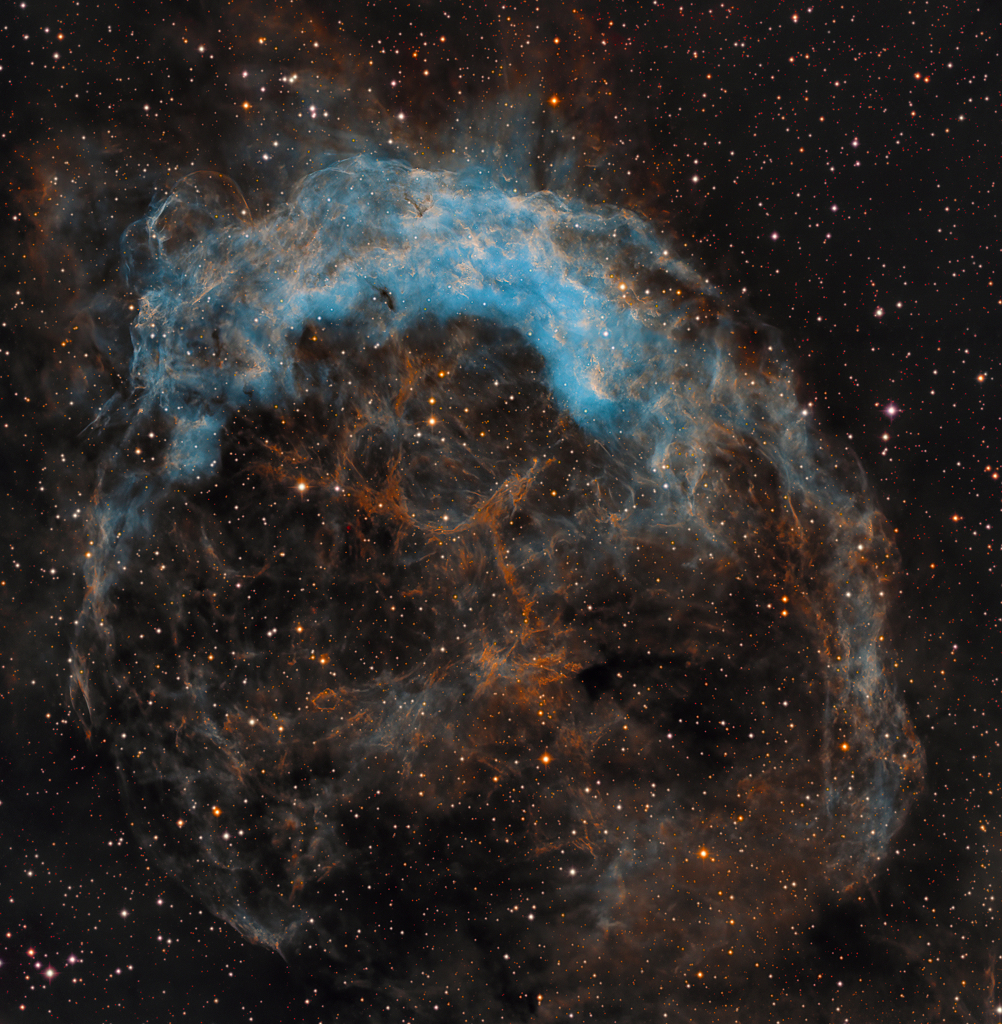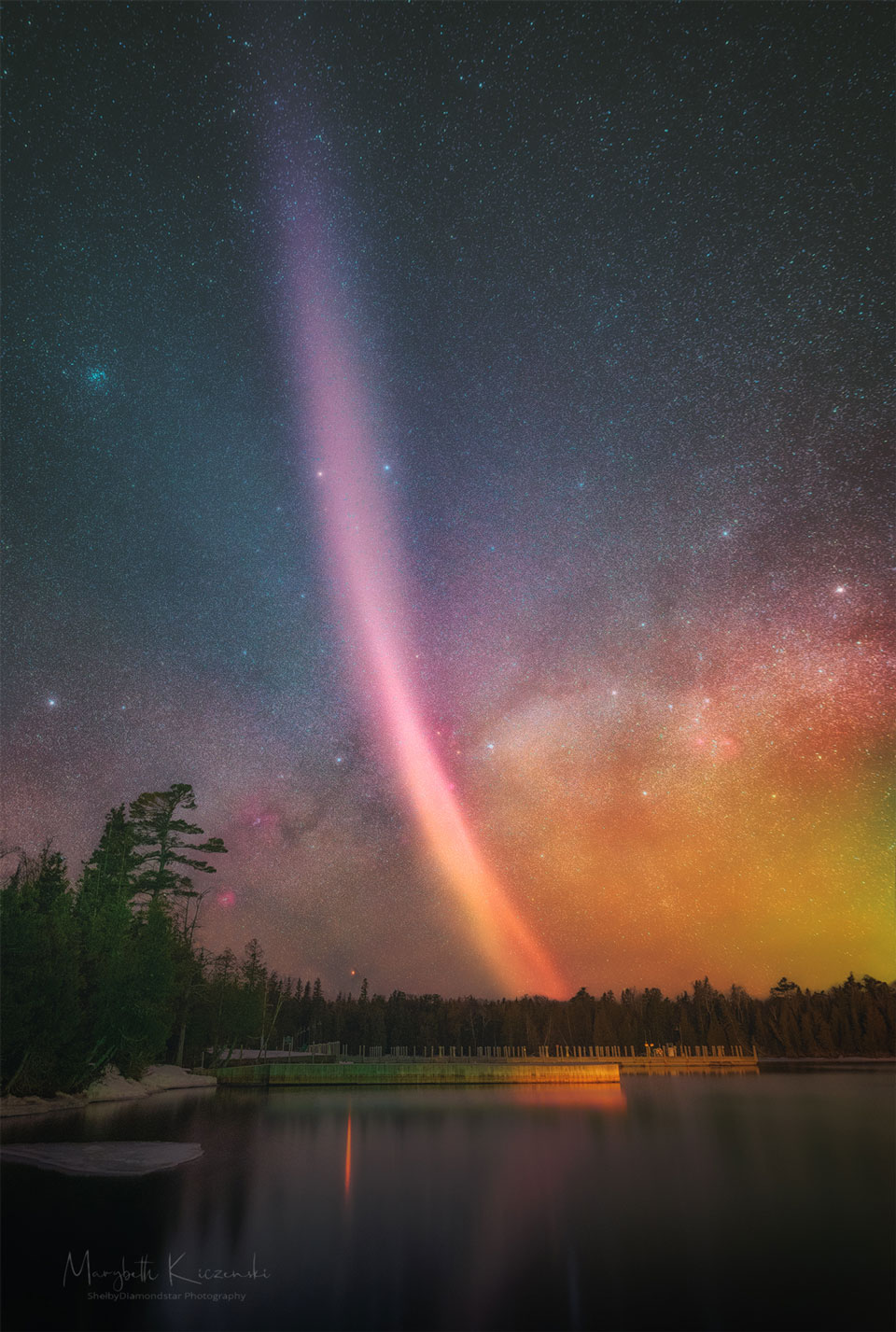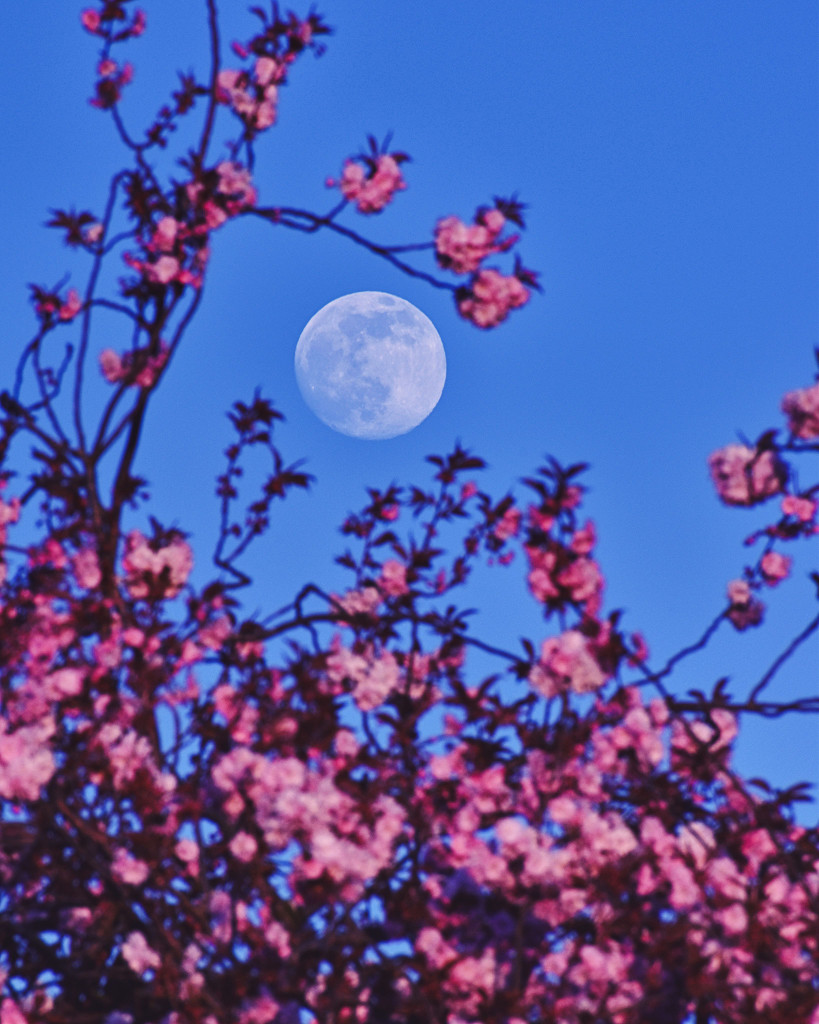Nombre total de pages vues
09/05/2021
PRATIQUE/POURQUOI - Pourquoi la Louisiane se nomme t-elle ainsi ?
08/05/2021
ASTRONOMY - Deepscape at Yacoraite
2021 May 8
Image Credit & Copyright: Franco Meconi
Explanation: In this evocative night scene a dusty central Milky Way rises over the ancient Andean archaeological site of Yacoraite in northwestern Argentina. The denizens of planet Earth reaching skyward are the large Argentine saguaro cactus currently native to the arid region. The unusual yellow-hued reflection nebula above is created by dust scattering starlight around red giant star Antares. Alpha star of the constellation Scorpius, Antares is over 500 light-years distant. Next to it bright blue Rho Ophiuchi is embedded in more typical dusty bluish reflection nebulae though. The deep night skyscape was created from a series of background exposures of the rising stars made while tracking the sky, and a foreground exposure of the landscape made with the camera and lens fixed on the tripod. In combination they produce the single stunning image and reveal a range of brightness and color that your eye can't quite perceive on its own.
07/05/2021
ASTRONOMY - Mercury-Redstone 3 Launch
2021 May 7
Image Credit: NASA
Explanation: Sixty years ago, near the dawn of the space age, NASA controllers "lit the candle" and sent Mercury astronaut Alan Shepard arcing into space atop a Redstone rocket. His cramped space capsule was dubbed Freedom 7. Broadcast live to a global television audience, the historic Mercury-Redstone 3 (MR-3) spacecraft was launched from Cape Canaveral Florida at 9:34 a.m. Eastern Time on May 5, 1961. The flight of Freedom 7, the first space flight by an American, followed less than a month after the first human venture into space by Soviet Cosmonaut Yuri Gagarin. The 15 minute sub-orbital flight achieved an altitude of 116 miles and a maximum speed of 5,134 miles per hour. As Shepard looked back near the peak of Freedom 7's trajectory, he could see the outlines of the west coast of Florida, Lake Okeechobe in central Florida, the Gulf of Mexico, and the Bahamas. Shepard would later view planet Earth from a more distant perspective and walk on the Moon as commander of the Apollo 14 mission.
06/05/2021
ASTRONOMY - Windblown NGC 3199
2021 May 6
Image Credit & Copyright: Mike Selby and Roberto Colombari
Explanation: NGC 3199 lies about 12,000 light-years away, a glowing cosmic cloud in the nautical southern constellation of Carina. The nebula is about 75 light-years across in this narrowband, false-color view. Though the deep image reveals a more or less complete bubble shape, it does look very lopsided with a much brighter edge along the top. Near the center is a Wolf-Rayet star, a massive, hot, short-lived star that generates an intense stellar wind. In fact, Wolf-Rayet stars are known to create nebulae with interesting shapes as their powerful winds sweep up surrounding interstellar material. In this case, the bright edge was thought to indicate a bow shock produced as the star plowed through a uniform medium, like a boat through water. But measurements have shown the star is not really moving directly toward the bright edge. So a more likely explanation is that the material surrounding the star is not uniform, but clumped and denser near the bright edge of windblown NGC 3199.
05/05/2021
ASTRONOMY - STEVE over Copper Harbor
Image Credit & Copyright: MaryBeth Kiczenski
Explanation: What creates STEVEs? Strong Thermal Emission Velocity Enhancements (STEVEs) have likely been seen since antiquity, but only in the past five years has it been realized that their colors and shapes make them different from auroras. Seen as single bright streaks of pink and purple, the origin of STEVEs remain an active topic of research. STEVEs may be related to subauroral ion drifts (SAIDs), a supersonic river of hot atmospheric ions. For reasons currently unknown, STEVEs are frequently accompanied by green "picket-fence" auroras. The featured STEVE image is a combination of foreground and background exposures taken consecutively in mid-March from Copper Harbor, Michigan, USA. This bright STEVE lasted several minutes, spanned from horizon to horizon, and appeared in between times of normal auroras.
04/05/2021
ASTRONOMY - Apollo 11: Earth, Moon, Spaceship
2021 May 4
Image Credit: NASA, Apollo 11; Restoration - Toby Ord
Explanation: After the most famous voyage of modern times, it was time to go home. After proving that humanity has the ability to go beyond the confines of planet Earth, the first humans to walk on another world -- Neil Armstrong and Buzz Aldrin -- flew the ascent stage of their Lunar Module back to meet Michael Collins in the moon-orbiting Command and Service Module. Pictured here on 1969 July 21 and recently digitally restored, the ascending spaceship was captured by Collins making its approach, with the Moon below, and Earth far in the distance. The smooth, dark area on the lunar surface is Mare Smythii located just below the equator on the extreme eastern edge of the Moon's near side. It is said of this iconic image that every person but one was in front of the camera.
02/05/2021
ASTRONOMY - Clouds of the Carina Nebula
Image Credit & Copyright: John Ebersole
Explanation: What forms lurk in the mists of the Carina Nebula? The dark ominous figures are actually molecular clouds, knots of molecular gas and dust so thick they have become opaque. In comparison, however, these clouds are typically much less dense than Earth's atmosphere. Featured here is a detailed image of the core of the Carina Nebula, a part where both dark and colorful clouds of gas and dust are particularly prominent. The image was captured in mid-2016 from Siding Spring Observatory in Australia. Although the nebula is predominantly composed of hydrogen gas -- here colored green, the image was assigned colors so that light emitted by trace amounts of sulfur and oxygen appear red and blue, respectively. The entire Carina Nebula, cataloged as NGC 3372, spans over 300 light years and lies about 7,500 light-years away in the constellation of Carina. Eta Carinae, the most energetic star in the nebula, was one of the brightest stars in the sky in the 1830s, but then faded dramatically.
01/05/2021
ASTRONOMY - Perseverance from Ingenuity
2021 May 1
Image Credit: NASA, JPL-Caltech, Ingenuity
Explanation: Flying at an altitude of 5 meters (just over 16 feet), on April 25 the Ingenuity helicopter snapped this sharp image. On its second flight above the surface of Mars, its color camera was looking back toward Ingenuity's current base at Wright Brothers Field and Octavia E. Butler Landing marked by the tracks of the Perseverance rover at the top of the frame. Perseverance itself looks on from the upper left corner about 85 meters away. Tips of Ingenuity's landing legs just peek over the left and right edges of the camera's field of view. Its record setting fourth flight completed on April 30, Ingenuity collected images of a potential new landing zone before returning to Wright Brothers Field. Ingenuity's fifth flight would be one-way though as the Mars aircraft moves on to the new airfield, anticipating a new phase of operational demonstration flights.
30/04/2021
PRATIQUE/POURQUOI - Pourquoi y a t-il la syllabe ''di'' dans les jours de la semaine ?
Dies veut dire jour en latin donc cela veut dire jour de la Lune pour Lundi, jour de Mars pour Mardi, etc.
ASTRONOMY - Pink and the Perigee Moon
2021 April 30
Image Credit & Copyright: Alice Ross
Explanation: On April 25 a nearly full moon rose just before sunset. Welcomed in a clear blue sky and framed by cherry blossoms, its familiar face was captured in this snapshot from Leith, Edinburgh, Scotland. Known to some as a Pink Moon, April's full lunar phase occurred with the moon near perigee. That's the closest point in its not-quite-circular orbit around planet Earth, making this Pink Moon one of the closest and brightest full moons of the year. If you missed it, don't worry. Your next chance to see a full perigee moon will be on May 26. Known to some as a Flower Moon, May's full moon will actually be closer to you than April's by about 98 miles (158 kilometers), or about 0.04% the distance from the Earth to the Moon at perigee.
ASTRONOMY - Chamaeleon Dark Nebulas
2025 November 19 Chamaeleon Dark Nebulas Image Credit & Copyright: Xinran Li & Houbo Zhao Explanation: Sometimes the dark dust ...

-
2022 September 26 All the Water on Planet Earth Illustration Credit: Jack Cook, Adam Nieman, Woods Hole Oceanographic Institution ; Data ...
-
2025 May 11 The Surface of Venus from Venera 14 Image Credit: Soviet Planetary Exploration Program , Venera 14 ; Processing & Copyri...









